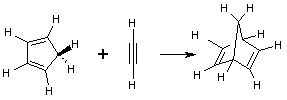
Norbornadiene
Encyclopedia
Norbornadiene is an organic compound
. This bicyclic hydrocarbon
is the most stable diolefin derived from the norbornane and norbornene
. Norbornadiene is primarily of interest as a ligand
in homogeneous catalysis
, but it has been heavily studied due to its high reactivity and distinctive structural property of being a diene
that cannot isomerize.
between a cyclopentadiene
and an alkyne
.
, a valence isomer
, can be obtained from norbornadiene by a photochemical reaction when assisted by a sensitizer such as acetophenone
:
The norbornadiene-quadricyclane couple is of potential interest for solar energy storage when controlled release of the strain energy
stored in quadricyclane back to norbornadiene is made possible.
Norbornadiene is reactive in cycloaddition
reactions. Norbornadiene is also the starting material for the synthesis of diamantane and sumanene
and it is used as an acetylene
transfer agent for instance in reaction with 3,6-di-2-pyridyl-1,2,4,5-tetrazine.
, where it serves as a two-electron or four-electron donor. The norbornadiene analogue of cyclooctadiene rhodium chloride dimer is widely used in homogeneous catalysis
. Chiral, C2-symmetric dienes derived from norbornadiene have also been described.
One example is tetracarbonyl(norbornadiene)chromium(0), which is a useful source of "chromium tetracarbonyl
," e.g. in reactions with phosphine ligand
s.
Organic compound
An organic compound is any member of a large class of gaseous, liquid, or solid chemical compounds whose molecules contain carbon. For historical reasons discussed below, a few types of carbon-containing compounds such as carbides, carbonates, simple oxides of carbon, and cyanides, as well as the...
. This bicyclic hydrocarbon
Hydrocarbon
In organic chemistry, a hydrocarbon is an organic compound consisting entirely of hydrogen and carbon. Hydrocarbons from which one hydrogen atom has been removed are functional groups, called hydrocarbyls....
is the most stable diolefin derived from the norbornane and norbornene
Norbornene
Norbornene or norbornylene or norcamphene is a bridged cyclic hydrocarbon. It is a white solid with a pungent sour odor. The molecule consists of a cyclohexene ring bridged with a methylene group in the para position...
. Norbornadiene is primarily of interest as a ligand
Ligand
In coordination chemistry, a ligand is an ion or molecule that binds to a central metal atom to form a coordination complex. The bonding between metal and ligand generally involves formal donation of one or more of the ligand's electron pairs. The nature of metal-ligand bonding can range from...
in homogeneous catalysis
Homogeneous catalysis
In chemistry, homogeneous catalysis is a sequence of reactions that involve a catalyst in the same phase as the reactants. Most commonly, a homogeneous catalyst is codissolved in a solvent with the reactants.-Acid catalysis:...
, but it has been heavily studied due to its high reactivity and distinctive structural property of being a diene
Diene
In organic chemistry a diene or diolefin is a hydrocarbon that contains two carbon double bonds.Conjugated dienes are functional groups, with a general formula of CnH2n-2. Dienes and alkynes are functional isomers...
that cannot isomerize.
Synthesis
Norbornadiene forms via the Diels-Alder reactionDiels-Alder reaction
The Diels–Alder reaction is an organic chemical reaction between a conjugated diene and a substituted alkene, commonly termed the dienophile, to form a substituted cyclohexene system. The reaction can proceed even if some of the atoms in the newly formed ring are not carbon...
between a cyclopentadiene
Cyclopentadiene
Cyclopentadiene is an organic compound with the formula C5H6. This colorless liquid has a strong and unpleasant odor. At room temperature, this cyclic diene dimerizes over the course of hours to give dicyclopentadiene via a Diels–Alder reaction...
and an alkyne
Alkyne
Alkynes are hydrocarbons that have a triple bond between two carbon atoms, with the formula CnH2n-2. Alkynes are traditionally known as acetylenes, although the name acetylene also refers specifically to C2H2, known formally as ethyne using IUPAC nomenclature...
.
Reactions
QuadricyclaneQuadricyclane
Quadricyclane is a strained, multi-cyclic hydrocarbon with potential uses as an additive for rocket propellants as well in solar energy conversion. These uses are limited, however, by the molecule's decomposition at relatively low temperatures .-Structure and properties:Quadricyclane is a highly...
, a valence isomer
Isomer
In chemistry, isomers are compounds with the same molecular formula but different structural formulas. Isomers do not necessarily share similar properties, unless they also have the same functional groups. There are many different classes of isomers, like stereoisomers, enantiomers, geometrical...
, can be obtained from norbornadiene by a photochemical reaction when assisted by a sensitizer such as acetophenone
Acetophenone
Acetophenone is the organic compound with the formula C6H5CCH3. It is the simplest aromatic ketone. This colourless, viscous liquid is a precursor to useful resins and fragrances.-Production:Acetophenone can be obtained by a variety of methods...
:
The norbornadiene-quadricyclane couple is of potential interest for solar energy storage when controlled release of the strain energy
Strain energy
In a molecule, strain energy is released when the constituent atoms are allowed to rearrange themselves in a chemical reaction or a change of chemical conformation in a way that:* angle strain,* torsional strain,* ring strain and/or steric strain,...
stored in quadricyclane back to norbornadiene is made possible.
Norbornadiene is reactive in cycloaddition
Cycloaddition
A cycloaddition is a pericyclic chemical reaction, in which "two or more unsaturated molecules combine with the formation of a cyclic adduct in which there is a net reduction of the bond multiplicity." The resulting reaction is a cyclization reaction.Cycloadditions are usually described by the...
reactions. Norbornadiene is also the starting material for the synthesis of diamantane and sumanene
Sumanene
Sumanene is a polycyclic aromatic hydrocarbon and of scientific interest because the molecule can be considered a fragment of buckminsterfullerene. Suman means "sunflower" in both Hindi and Sanskrit. The core of the arene is a benzene ring and the periphery consists of alternating benzene rings ...
and it is used as an acetylene
Acetylene
Acetylene is the chemical compound with the formula C2H2. It is a hydrocarbon and the simplest alkyne. This colorless gas is widely used as a fuel and a chemical building block. It is unstable in pure form and thus is usually handled as a solution.As an alkyne, acetylene is unsaturated because...
transfer agent for instance in reaction with 3,6-di-2-pyridyl-1,2,4,5-tetrazine.
As a ligand
Norbornadiene is a versatile ligand in organometallic chemistryOrganometallic chemistry
Organometallic chemistry is the study of chemical compounds containing bonds between carbon and a metal. Since many compounds without such bonds are chemically similar, an alternative may be compounds containing metal-element bonds of a largely covalent character...
, where it serves as a two-electron or four-electron donor. The norbornadiene analogue of cyclooctadiene rhodium chloride dimer is widely used in homogeneous catalysis
Homogeneous catalysis
In chemistry, homogeneous catalysis is a sequence of reactions that involve a catalyst in the same phase as the reactants. Most commonly, a homogeneous catalyst is codissolved in a solvent with the reactants.-Acid catalysis:...
. Chiral, C2-symmetric dienes derived from norbornadiene have also been described.
One example is tetracarbonyl(norbornadiene)chromium(0), which is a useful source of "chromium tetracarbonyl
Chromium carbonyl
Chromium carbonyl, also known as chromium hexacarbonyl, is the chemical compound with the formula Cr6. At room temperature the solid is stable to air, although it does have a high vapor pressure and sublimes readily. Cr6 is zerovalent, meaning that Cr has a formal charge of zero, and it is called...
," e.g. in reactions with phosphine ligand
Ligand
In coordination chemistry, a ligand is an ion or molecule that binds to a central metal atom to form a coordination complex. The bonding between metal and ligand generally involves formal donation of one or more of the ligand's electron pairs. The nature of metal-ligand bonding can range from...
s.


